Over 125 Years Of Oilseed Processing
Published: June 8, 2018
By: Eric Stibora, Chemical Engineer, Director of Capital Equipment Sales & Marketing at Anderson International Corp.
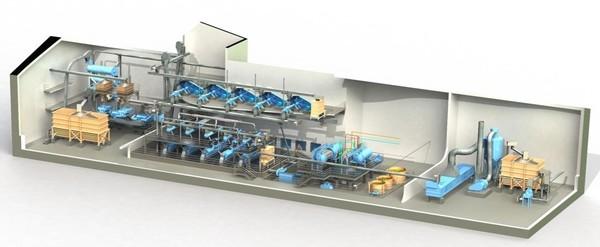
COMPLETE OIL MILL PLANT DESIGN AND OPTIMIZATION


Introduction to Oilseed Processing
The primary goal of oilseed processing is to extract as much oil as possible from the seed while consuming as little energy as possible, resulting in two end products, oil and the left over solids traditionally called meal.

The oil can be used in food products, animal feed, cosmetics, pharmaceuticals, and production of renewable fuel. The solids are sold as additives for use in both human food and animal feed products or used as a simple fertilizer. The quality of these end products is determined by the seed, the quality of the raw material, and most importantly the processing techniques that are utilized to recover the oil. The two most popular methods of oil recovery are chemical extraction with a solvent and brute force with a screw press or Expeller® press. However, there is a lot more involved in oilseed processing than just the extraction step.
Oilseed processing can be broken down into three major steps:

Preparation
The goal of the preparation steps is to make the extraction or separation of the oil from the solids as low cost and efficient as possible. To appreciate the significance of preparation it is important to understand that the oil is not simply absorbed in a solid matrix like water in a sponge that can be easily rung out. The oil or fat is a well-protected energy source stored inside oil bodies surrounded by cellular membranes within a cell wall.

TEM of soybean cotyledon cell cross-section. PB, protein body; CW, cell wall; N, cell nucleus; OB, oil body. K. A. Campbell and C. E. Glatz, J. Agric. Food Chem., 2009, 57, 10904–1091
Feeding a whole oilseed to the extraction step without any preparation would result in minimum rates and oil yield due to the difficulty of accessing this oil. The preparation steps break down the oilseed and condition the material to a state where it is as easy as possible to separate out the oil from the solids in order to maximize the efficiency of the extraction method being used. The steps and equipment will vary based on the oilseed being processed and the extraction method being employed. Preparation can be broken down into three main categories, cleaning, size reduction, and heat treatment.

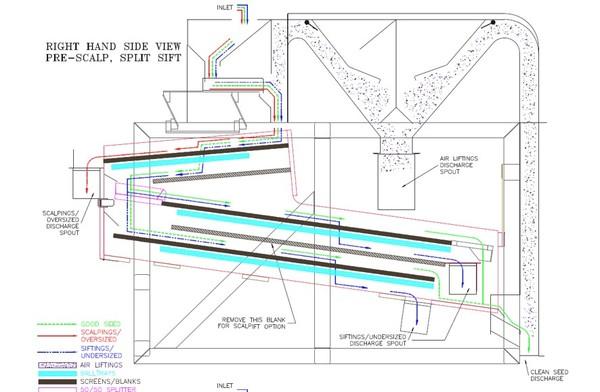
Photo Courtesy of AT Ferrell Company Inc.




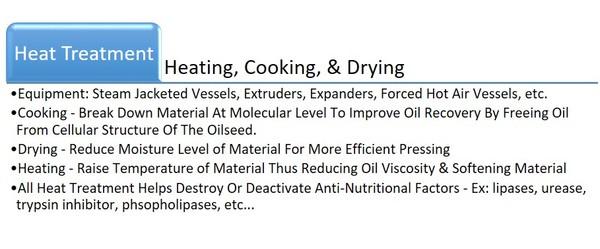
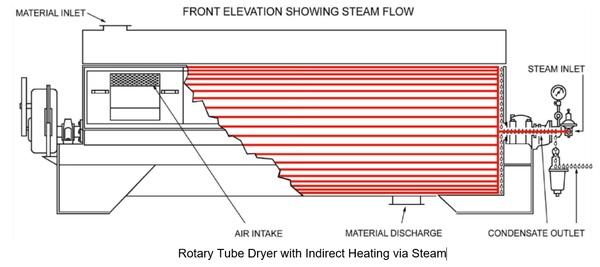
Extraction
The two most common methods for separating the oil from the oilseed are chemical extraction and mechanical extraction. In chemical or solvent extraction, the material is fed into a large compartmentalized vessel. The compartments move from the inlet of the vessel to the outlet in a circular, closed loop. The material is subjected to a number of baths/washes with hexane to chemically dissolve the oil out. The oil recovery in a solvent extraction plant is the highest among any extraction method with oil losses in the meal usually less than 1%. However, the meal can contain over 30% residual hexane with an even higher concentration in the oil. Due to the toxicity and flammability of hexane, it is recovered from the oil and meal product streams and recycled back to the process for reuse.
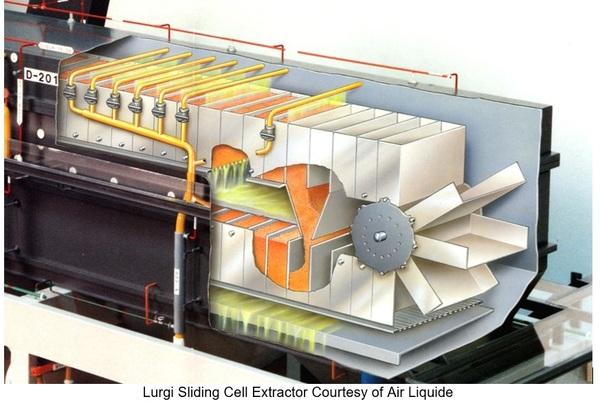
Mechanical Extraction is accomplished with a screw press. The oil bearing material is fed at a constant rate into a rotating screw within a perforated barrel. The screw geometry is such that as the material is pushed forward it encounters less and less open space resulting in compression. The high pressure forces the non-compressible liquid out of the compressible solid and perforations in the barrel allow the oil to drain out while the solid product remains inside until discharging at the end of the rotating screw. While oil losses in the meal are higher around 5-8%, the mechanical process does not expose the products to any harmful chemicals.
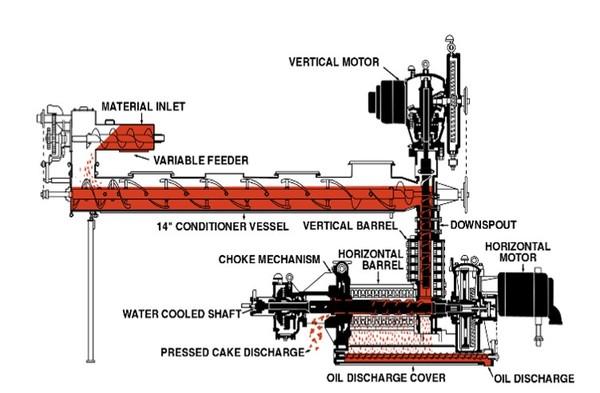
Anderson International Super Duo™ Expeller® Press Diagram with Dual Pressing Sections.
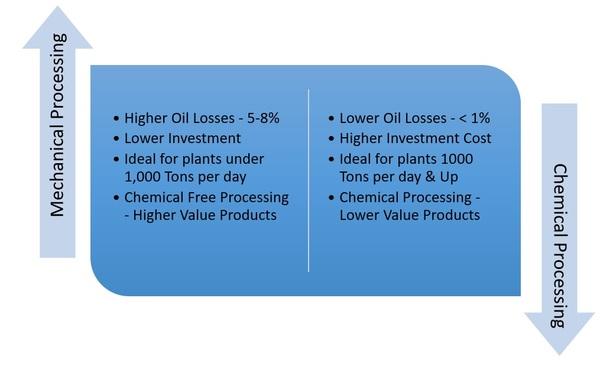
Meal & Oil Handling (Solvent)
Product handling will differ based on the type of extraction method employed. In solvent extraction, both the meal and oil streams are contaminated with a large amount of hexane. The hexane must be removed before the products are viable to the market.
The combination of the oil & hexane product is referred to as miscella in the industry. This mixture is sent to a series of evaporators to boil off enough hexane until the hexane content is below the industry allowable maximum. From there the oil is sent to temporary storage before being sold as crude oil or further processed into RBD (refined, bleached, & deodorized) oil. The vaporized hexane is sent to a condenser and recycled to the extractor.
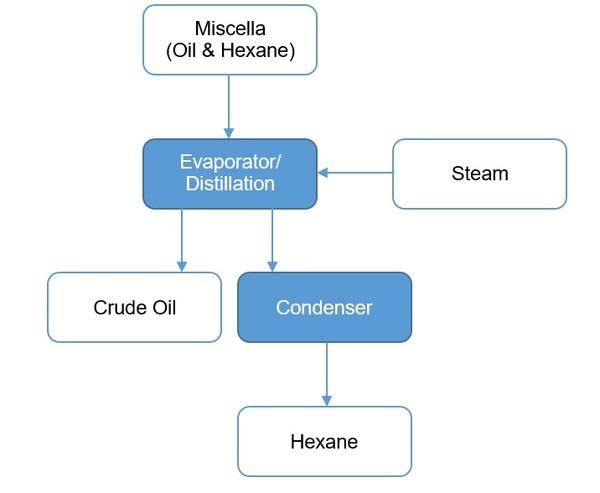
The hexane soaked meal is referred to as marc. The marc, just like the miscella, must have the hexane level reduced to industry allowable levels before qualifying for the market. The marc is sent to a large cylindrical vessel made up of many levels with a rotating shaft through the entire unit from top to bottom. Each level has an arm attached to this rotating shaft to agitate the material and keep it moving towards the next stage through an opening in the bottom of each stage. Each level is jacketed to allow for indirect steam heating with direct sparge steam applied in the top levels. The product continues down while the hexane evaporates upward and out into another condenser. This unit is called a desolventizer-toaster. From the desolventizer, the material is dried down to 10% moisture and cooled to near ambient conditions before being ground up into a uniform sized meal.
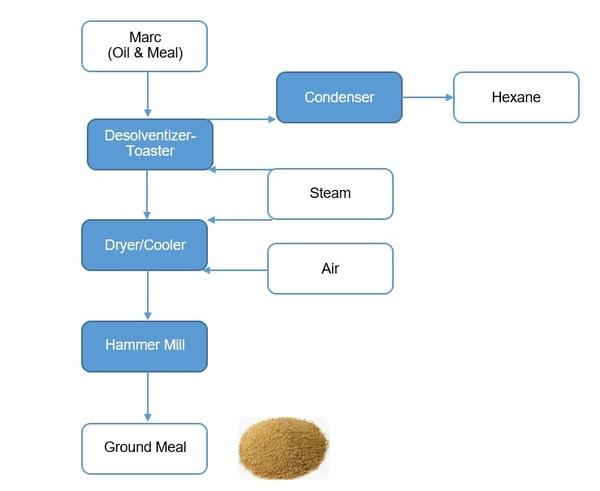
Meal & Oil Handling (Mechanical)
Unlike solvent plants, the products from the Expeller® press are not contaminated with harmful chemicals, but a few steps are still required before arriving at the finished products.

While the oil is not contaminated by any chemicals, there are a number of solids that make it through the Expeller® barrel with the oil. The fines content in the oil can be 10-20% with 15% being typical. There are many ways to separate out the fines from the oil, but the two most popular utilize a filter or decanter.
The decanter option is very simple as all that is required is a continuous supply of the oil with sediment being pumped into the device and the decanter uses centrifugal force to separate the heavier fines from the liquid oil.

The Filtration option requires a little more equipment, but consumes significantly less electrical energy. The process is broken up into two stage with a screening system used first to remove the larger and heavier fines.
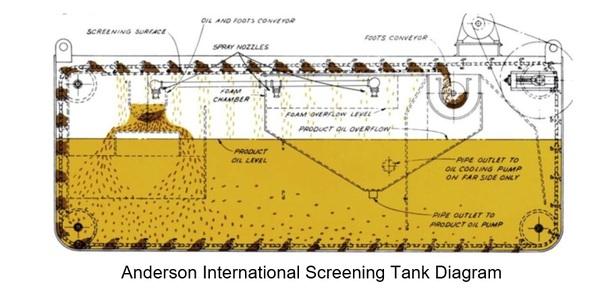
The screening tank above requires only a 2 HP motor to move the paddles around the tank in a circular motion.
1. Oil and fines are fed into tank
2. Fines settle to the bottom
3. The paddles continuously scoop the fines from the bottom
4. The fines a dragged across a wedge wire screen to drain
5. Fines are recycled to the process
2. Fines settle to the bottom
3. The paddles continuously scoop the fines from the bottom
4. The fines a dragged across a wedge wire screen to drain
5. Fines are recycled to the process
From the screening tank the oil now containing no more than 5% fines by weight is sent to a temporary holding tank. From the holding tank the oil is pumped through a pressurized vessel where the solids build up on the filter elements and the oil passes through, free of particulate.

Pressure Leaf Filter System Diagram; Courtesy of Envirogen Group
After 2-4 hours the filter elements will become so full of solids that the oil requires more pressure than is available to travel through the bed of material. The filter cycle is stopped, the fines are removed, and the cycle can start over again.
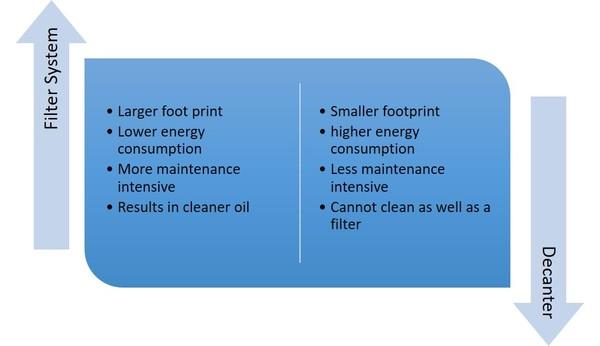
Related topics:
Authors:
Anderson International Corp
Recommend
Comment
Share
R & D Equipment Co
18 de junio de 2018
Preparation in terms of particle reduction so we can dry more efficiently to reach the desired moisture content are critical in order to extract oil from copra. We have extensive hands on experience of over 30 years with many customers processing copra in many countries like Mexico and the Philippines where we have sold several hundreds both used and rebuilt to factory specifications machines for copra and for VCO.WE KNOW HOW TO REBUILD EXPELLERS RIGHT In case you wish to discuss your specific application or project we are available anytime during business hours.
Recommend
Reply
susheela group
18 de junio de 2018
We are manufacturing poultry meal at Hyderabad in India. We are looking fat press for fat extraction in poultry by-product meal. This meal contains 45% fat (capacity per hour 2 tons).
Please confirm, do have any fat press for poultry meal extraction?
Recommend
Reply
Recommend
Reply

Would you like to discuss another topic? Create a new post to engage with experts in the community.








